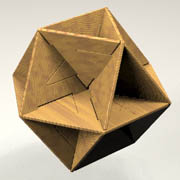5.2. One mortise two tenons. The idea of using two tenons instead of one to fill one mortise opened up a completely new field of slide together structures. In many 3d structures you can find intersecting planes. The idea was, when you have a set of intersecting planes, to split up one of the planes in such a way that you get two tenons crossing the intersection line with the other plane from opposite directions. An example of such a tiling of a plane can be seen in Figure 31. Here the plane is divided into three equal pieces. The division line has a Z-shape to create the tenons. The Z-cut is made in such a way that the pieces can slide apart when moving from the center. Now each piece (Figure 32) has two sides with a tenon and in the middle is a mortise of such a size that two such tenons, coming from different directions, fit in precisely. Sliding together 12 pieces creates an intersection of four planes (Figure 33). The shape of the completed construction can be recognized as the cuboctahedron. Sliding together the 12 pieces is fairly easy to do. For me it was a surprise that taking the cuboctahedron apart is practically impossible.


Figure 31,32: Pieces




Figure 33a,b,c: Cuboctahedron - 12 pieces
5.3. Polyhedra. The cuboctahedron is one of the Archimedean polyhedra in which you can recognize a set of intersecting planes. The four planes have one intersection point in the center of the polyhedron; each of these planes is divided into three pieces. And now all the pieces can be moved towards this center point and the tenons will slide smoothly into the mortises.
Similar situations can be found in a few other polyhedra: the octahedron with three intersecting planes and the icosidodecahedron with six intersecting planes. In Figure 34 you can see a subdivision of one of the six planes of the icosidodecahedron into five equal pieces. Thirty such pieces can be slid together to create the icosidodecahedron of Figure 36.


Figure 34,35: Pieces




Figure 36a,b,c: Icosidodecahedron - 30 pieces